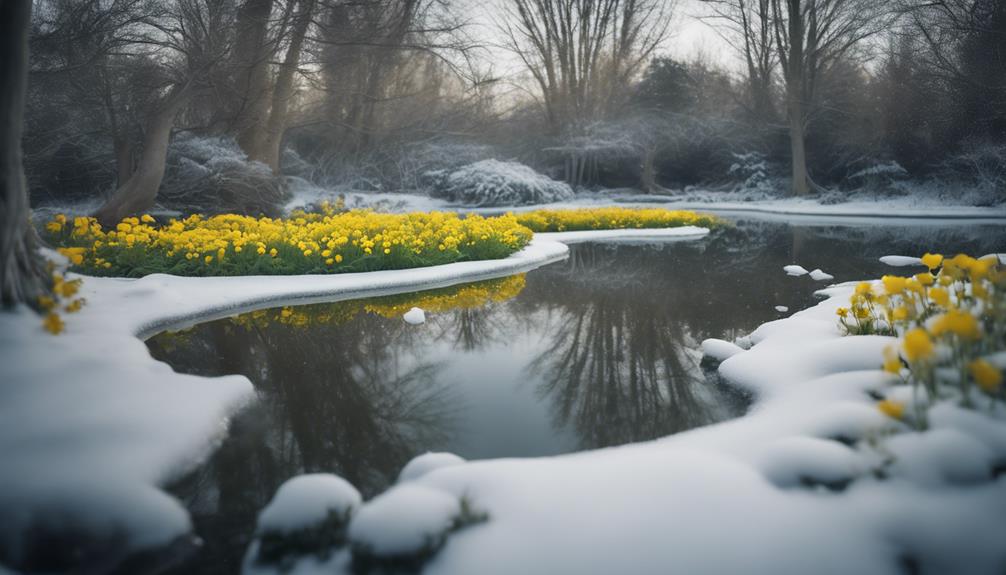You can create a thriving winter garden by choosing cold-hardy aquatic plants that adapt to freezing temperatures and reduced light levels. Consider plants like hardy water lilies, lotus, and corkscrew rush that can survive winter in zones as low as 3. Trim dead foliage every fall to promote new growth, and protect plants from freezing temperatures by moving pots to a deeper section of the pond. With minimal care, these plants will add visual interest to your winter garden, providing a sense of continuity and connection to your outdoor space. Discover more about these resilient plants and how to care for them to guarantee a stunning winter display.
Table of Contents
Key Takeaways
- Choose cold-hardy aquatic plants that thrive in local climate and specific growing conditions to guarantee survival and peak performance.
- Trim dead foliage every fall to promote new growth come spring and protect plants from freezing temperatures.
- Cold-hardy plants like water lilies and Anacharis can survive freezing temperatures and adapt to reduced light levels, adding visual interest to winter gardens.
- Hardy perennials require minimal care, can thrive in small container ponds, and bring joy and a sense of belonging to outdoor space during colder months.
- Divide and replant hardy perennials every fall to thrive in the following growing season, and consider packages tailored to specific pond needs.
Choosing the Right Winter Plants
When selecting cold-hardy aquatic plants for your winter garden, consider the specific growing conditions and hardiness zones required by each species to guarantee their survival and peak performance.
You'll want to choose plants that are winter hardy and can thrive in your local climate.
Hardy water lilies, like Atropurpurea and Prakisad, are a great choice, surviving winter in zones 3-11.
Marginal plants, such as Arrowhead plants, add interest with their tall, graceful stems and arrowhead-shaped leaves, growing in zones 3-8.
If you're looking for a robust, upright grower, Corkscrew Rush is a great option, thriving in zones 4-9.
Purple Pitcher Plants, a low-growing hardy perennial, take a couple of years to establish but can grow in zones 3-7.
The American Lotus requires regular feeding during the growing season, but its large leaves make it a stunning addition to your winter garden, thriving in zones 4-10.
Characteristics of Cold-Hardy Plants
You'll find that cold-hardy aquatic plants share certain characteristics that enable them to thrive in winter conditions, including their ability to survive freezing temperatures and adapt to reduced light levels. These plants are specifically designed to withstand the harsh winter environment, making them perfect for your water garden.
| Plant Type | Cold Hardiness | Care Requirements |
|---|---|---|
| Hardy Water Lilies | Survives frost | Minimal care, trim yellow/brown foliage |
| Anacharis | Thrives in zone 6b | Low maintenance, can be grown in small ponds |
| Hornwort | Tolerates cold temperatures | Propagate through root division or stem cuttings |
As you explore the world of cold-hardy plants, you'll notice that they require minimal care and can thrive in small container ponds. Hardy perennials, such as water lilies, still need some attention every fall to thrive. By understanding these characteristics, you'll be able to choose the right plants for your winter garden and create a beautiful and thriving water garden, even in the coldest of temperatures. With the right cold-hardy plants, you can enjoy your outdoor space year-round, knowing that your plants are hardy enough to withstand the winter weather.
Plant Care and Maintenance Tips
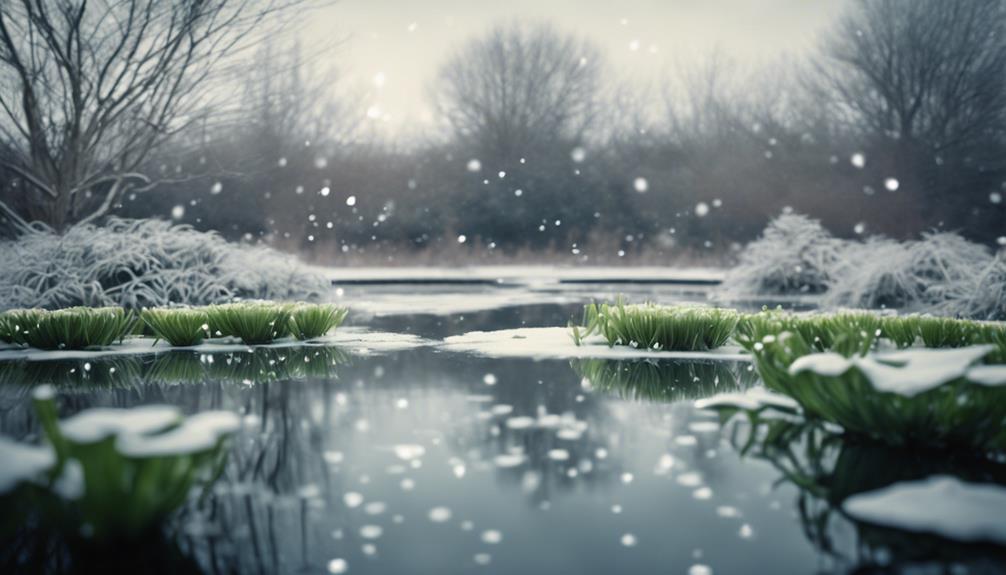
As you prepare your cold-hardy aquatic plants for the changing seasons, vital to prioritize winter care essentials to guarantee their survival.
You'll need to trim dead foliage, a pivotal step in maintaining plant health, and take measures to protect your plants from freezing temperatures.
Winter Care Essentials
To safeguard the health and vitality of your aquatic plants, trim off yellow or brown foliage every fall, a pivotal step in promoting new growth come spring.
As you prepare your hardy lilies and other water garden plants for the colder months, remember to move lotus pots to a deeper section of the pond to protect the roots from freezing temperatures.
For marginal plants like pitcher plants, plant them in groups of 3-5 to create a natural, lush appearance in your small ponds.
Even hardy perennials need care every fall, including dividing and replanting, to thrive in the following growing season.
If you have tropical plants, bring them inside or move them to a greenhouse to overwinter, as they're sensitive to frost and freezing temperatures.
By following these winter care essentials, you'll guarantee your pond plants remain healthy and vibrant throughout the cold months, providing a beautiful display when the weather warms up again.
With proper care, your pond will be a haven for you and your family to enjoy all year round, making it crucial for their survival and a necessity for their overall well-being.
Trimming Dead Foliage
By carefully trimming dead foliage from your cold-hardy aquatic plants, you're taking a proactive step to maintain their health and appearance throughout the winter months. This essential task not only removes unsightly yellow or brown leaves and stems but also helps prevent the spread of disease and encourages new growth in the spring.
| Benefits of Trimming Dead Foliage | Why It Matters |
|---|---|
| Prevents disease spread | Reduces risk of infection and promotes healthy growth |
| Encourages new growth | Prepares plants for spring blooms and lush foliage |
| Improves air circulation and sunlight penetration | Supports healthy plant development and reduces algae growth |
When trimming, use clean and sharp tools to make clean cuts just above a node or joint. This helps prevent spreading disease from one plant to another and promotes healthy growth. By removing dead foliage, you're also allowing your cold-hardy aquatic plants to conserve energy and survive the cold temperatures. In your water garden setting, this means a healthier and more vibrant aquatic pond plant, thanks to PlantsWater and Bog Filters.
Winter Hardy Pond Plant Options
Now that you've got a solid grasp on plant care and maintenance, it's time to explore the perfect winter hardy pond plant options for your water garden.
You'll want to choose plants that can thrive in cold temperatures, and we'll guide you through the best picks for your pond.
From hardy water lilies to bog plants, you'll discover a range of options that'll keep your pond looking great year-round.
Winter Pond Plants
You can choose from a variety of winter hardy pond plants that will add interest and beauty to your pond during the colder months.
Hardy water lilies, for instance, can thrive in 12-24 inches of water, while lotus pots should be moved to a deeper section of the pond for winter.
Perennial winter hardy pond plants like arrowhead, corkscrew rush, and purple pitcher plants can also add visual appeal to your pond.
Remember to feed your lotus and lilies regularly during the growing season to support their large leaves and blooms.
Consider planting pickerelweed in groups of 3-5 for its carefree growth habit and bold foliage.
As you prepare your pond for winter, don't forget to trim off yellow or brown foliage from your hardy perennials to keep them healthy.
Hardy Water Garden Options
Beyond the pond's surface, a diverse array of hardy water garden options awaits, each carefully adapted to thrive beneath the ice or in cold water, providing a wealth of opportunities to create a dynamic, winter-interest landscape.
You can choose from a range of live pond plants that are specifically bred to withstand freezing temperatures. Water lilies, for instance, are a popular choice, with some varieties hardy enough to survive in zones as low as 3.
The Lotus, a cousin of the water lily, is another option, with its elegant blooms adding a touch of elegance to your winter garden.
If you're looking for something a bit more exotic, consider adding some Parrots Feather to your pond. This tropical-looking plant is surprisingly hardy and can thrive in temperatures as low as 40°F.
For a more dramatic effect, try adding some Puerto Rico-native plants, like the Waterlily 'Escapada', which can grow up to 6 feet in diameter.
Benefits of Cold-Hardy Aquatic Plants
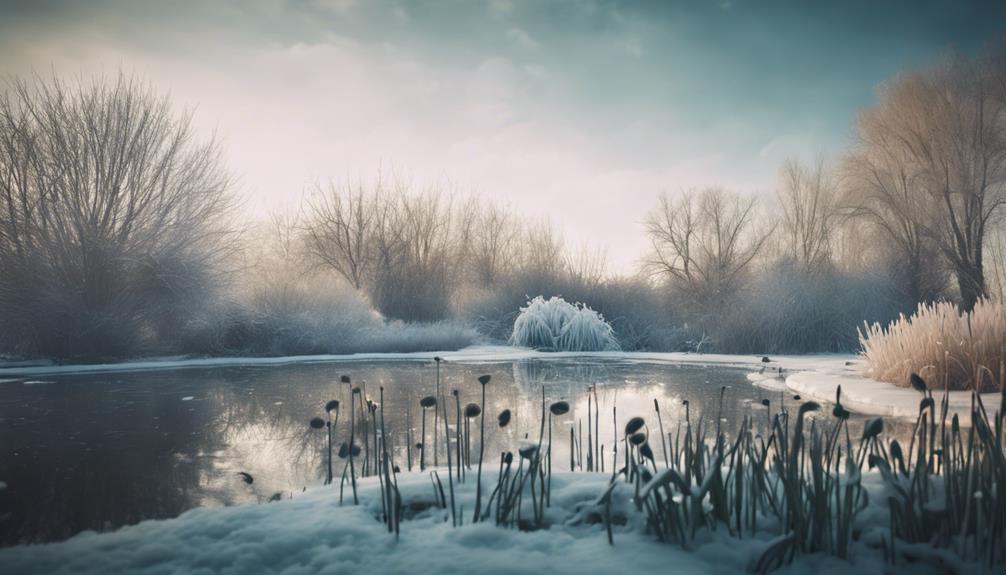
By incorporating cold-hardy aquatic plants into your pond design, you can enjoy a range of benefits that extend beyond the growing season. These plants require minimal care and can thrive in small container ponds, making them ideal for beginner pond owners. Regular pruning can help control their growth and keep them healthy during the winter months.
| Plant Type | Benefits | Ideal Pond Size |
|---|---|---|
| Hardy Water Lilies | Survive winter in almost any location | Large Ponds |
| Cold-Tolerant Plants | Require minimal care | Small Container Ponds |
| Anacharis | Tolerate cold snaps, suitable for zone 6b | Outdoor Ponds |
| Waterlily | Add variety and visual interest to winter gardens | Large Ponds |
| Ships Spring | Thrive in cold weather, ideal for winter gardens | Small Container Ponds |
Cold-hardy aquatic plants can add variety and visual interest to winter gardens, even in frozen ponds. They can also provide a sense of continuity and connection to your outdoor space during the colder months. By choosing the right cold-hardy aquatic plants for your pond, you can enjoy a beautiful and thriving winter garden that brings you joy and a sense of belonging.
Propagation and Pruning Techniques
When it comes to maintaining the health and appearance of your cold-hardy aquatic plants, proper propagation and pruning techniques are vital to guarantee their continued growth and thrive.
To propagate your cold-hardy aquatic plants, you'll want to divide and replant them in the spring when new growth appears. Use a sharp, clean tool to minimize damage to the roots and rhizomes. For water lilies, gently twist and pull apart the rhizomes, making sure each section has at least one 'eye' or growing point, and then replant them in a new location with fresh soil and water.
You can also propagate using stem cuttings, cutting sections of stem from the parent plant, removing lower leaves, and planting them in a pot or directly into the pond.
Pruning is also essential, involving cutting back dead or damaged foliage in the fall to prevent decay and encourage new growth, and trimming back overgrown plants in the spring to maintain shape and promote healthy growth.
Regular pruning will help control growth, encourage blooming, and improve overall appearance, preventing your plants from becoming too dense and shading out other plants.
Winter Pond Plant Collections and Accessories
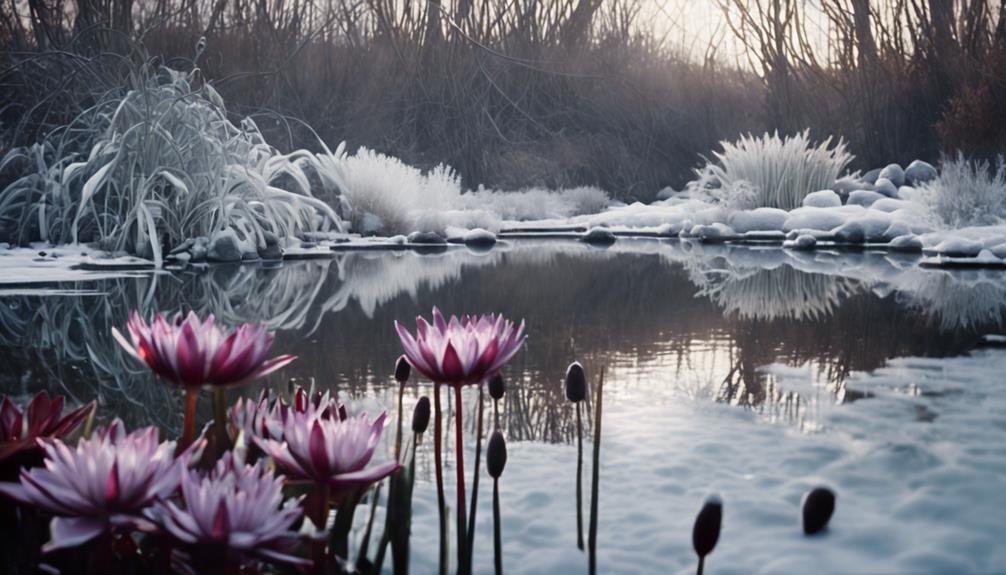
You can enhance your winter pond's beauty and functionality with carefully curated plant collections and accessories specifically designed for the cold season.
Consider packages for small ponds, large ponds, bog filters, and more, which include a variety of cold-hardy aquatic plants suitable for winter gardens. For instance, the Grower's Choice package offers a selection of pond plants tailored to your specific needs.
To promote healthy growth, use Waterlily World Pond Tabs + Humates, a fertilizer specifically designed for waterlilies, lotus, and other aquatic plants. PondGrow Containers are another great option, delivering oxygen to the roots of aquatic plants, making them ideal for winter gardens and small ponds.
If you're looking for a more natural appearance, midlevel pond plants like cattails and irises thrive in 4-12 inches of water and are suitable for winter gardens. For guidance on planting and caring for these plants, visit the PondMegastore website for detailed instructions.
Native and Bog Plant Varieties
Incorporating native and bog plant varieties into your winter pond design can add a touch of natural elegance and diversity to the ecosystem.
As you explore live pond plants, consider Sweetflag (Acorus Calmus), a wonderful native herbaceous plant that's a great alternative to the invasive cattail.
Blue Rush (Juncus) is another attractive option, growing 18-24 inches tall in moist soil or up to three inches of water above the soil.
If you're looking for a pop of color, Orange Louisiana Iris is a bright, perky specimen with a stunning red and yellow color combination on its showy flower petals.
When it comes to bog plants, Thalia Dealbata or Hardy Water Canna is a lovely aquatic plant with large, handsome, blue-green leaves.
Blue Flag Iris is another standout, with lovely, deep, bluish-purple blooms on its attractive iris with blue-green, sword-like foliage.
These native and bog plant varieties can thrive in your winter garden, adding a touch of natural beauty and diversity to your water feature.
Plant Availability and Shipping Information
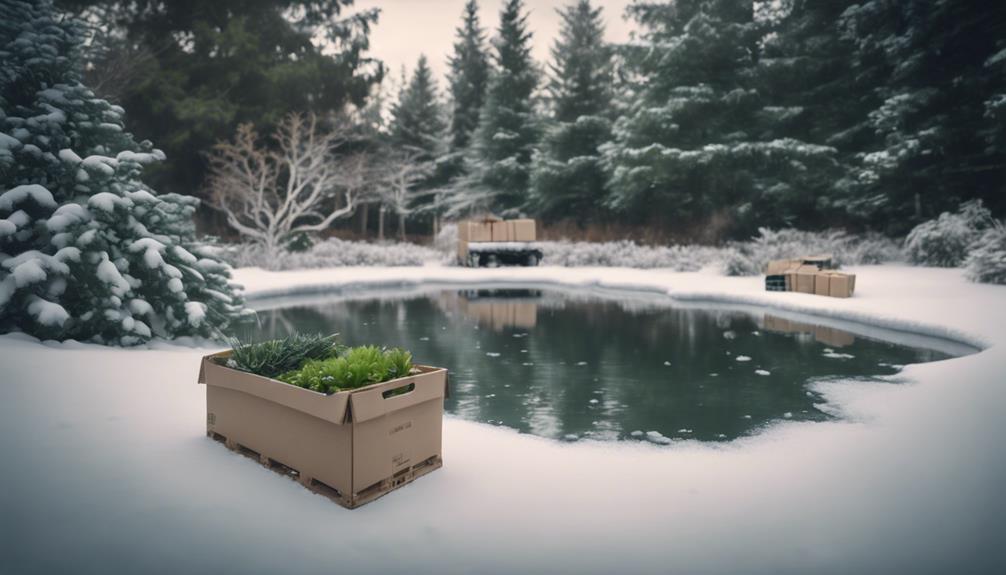
Shipping restrictions and regional availability play a crucial role in getting your chosen cold-hardy aquatic plants to your doorstep.
As you explore the world of winter gardens, it's imperative to understand the limitations of shipping certain plants to specific regions. For instance, marginal bog plants aren't available to ship to Arizona, California, and Puerto Rico due to state agricultural laws prohibiting shipping potted plants with soil into these states.
Before ordering, you should check local laws to confirm you can receive your desired plants.
Perennial bog plants, on the other hand, are shipped in 2 Net Pots and are hardy pond plants that aren't new seedlings or starts.
These plants are available to ship to most states, and you can check the website for availability and shipping information. The website also provides a list of available cold-hardy aquatic plants, including water lilies, bog plants, and floaters, with details on shipping and availability.
Frequently Asked Questions
What Floating Pond Plants Survive Winter?
You'll find that Floating Azolla, being winter hardy and cold tolerant, can thrive in icy conditions, providing frost-resistant pond coverage, making it an ideal choice for your winter garden, alongside other floating pond plants that survive winter.
Can I Leave Pond Plants in the Pond Over Winter?
Ironically, you think you can simply leave your pond plants in the pond over winter, but you'll need to ponder pond depth, prep them properly, choose the right plants, guarantee water circulation, and protect from frost to keep them thriving.
What to Do With Aquatic Plants in Winter?
As winter approaches, you'll need to prioritize aquatic maintenance, relocating sensitive plants to frost-protected areas, and understanding dormancy stages to guarantee a smooth seasonal shift, all while planning winter care to keep your plants thriving.
Can Aquatic Plants Grow in Cold Water?
You'll be pleased to know that many aquatic plants can grow in cold water, leveraging adaptations like cold tolerance, winter dormancy, and frost protection to thrive in temperatures as low as 40°F (4°C), depending on the species.
Conclusion
As you gaze out at your winter garden, you can't help but wonder what secrets lie beneath the frozen surface.
Will your cold-hardy aquatic plants survive the harsh temperatures, or will they emerge in the spring, stronger and more vibrant than ever?
The answer lies in the care and attention you give them now.
With the right techniques and plant choices, your winter pond can be a haven for life and beauty, waiting to be revealed when the thaw comes.

